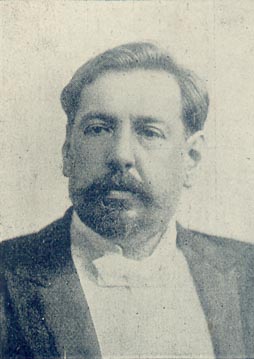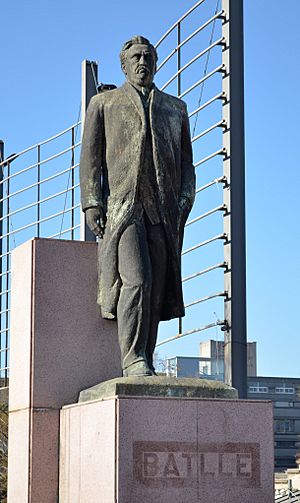José Batlle y Ordóñez facts for kids
Quick facts for kids
José Batlle y Ordóñez
|
|
|---|---|

José Batlle y Ordóñez
|
|
| 19th and 21st President of Uruguay | |
| In office 1 March 1911 – 1 March 1915 |
|
| Preceded by | Claudio Williman |
| Succeeded by | Feliciano Viera |
| In office 1 March 1903 – 1 March 1907 |
|
| Preceded by | Juan Lindolfo Cuestas |
| Succeeded by | Claudio Williman |
| In office 5 February 1899 – 1 March 1899 Acting |
|
| Preceded by | Juan Lindolfo Cuestas |
| Succeeded by | Juan Lindolfo Cuestas |
| 2nd and 5th Prime Minister of Uruguay | |
| In office 1 March 1921 – 1 March 1923 |
|
| President | Baltasar Brum |
| Preceded by | Feliciano Viera |
| Succeeded by | Julio María Sosa |
| In office 1 March 1927 – 16 February 1928 |
|
| President | Juan Campisteguy |
| Preceded by | Luis Alberto de Herrera |
| Succeeded by | Luis Caviglia |
| President of the Senate of Uruguay | |
| In office 1899–1900 |
|
| Preceded by | Carlos de Castro |
| Succeeded by | Juan Carlos Blanco Fernández |
| In office 1903–1903 |
|
| Preceded by | Juan Carlos Blanco Fernández |
| Succeeded by | Juan P. Castro |
| Member of the Senate of Uruguay | |
| In office 9 February 1899 – 5 February 1902 |
|
| Constituency | Montevideo Department |
| In office 8 February 1902 – 1 March 1903 |
|
| Constituency | Montevideo Department |
| Member of the Chamber of Representatives | |
| In office 15 February 1891 – 14 February 1894 |
|
| Constituency | Salto Department |
| Personal details | |
| Born | May 21, 1856 Montevideo, Uruguay |
| Died | October 20, 1929 (aged 73) Montevideo, Uruguay |
| Political party | Colorado Party |
| Spouse | Matilde Pacheco |
| Relations |
|
| Children |
|
| Parent |
|
| Occupation | Journalist |
José Pablo Torcuato Batlle y Ordóñez (born May 23, 1856, died October 20, 1929) was a very important Uruguayan politician. People often called him Don Pepe. He served as President of Uruguay twice for the Colorado Party.
José Batlle y Ordóñez was the son of a former president. He is famous for creating a political system called Batllism. This system helped modernize Uruguay by bringing in many social reforms. He introduced ideas like unemployment pay, eight-hour workdays, and universal suffrage (the right for everyone to vote). He also made high school education free.
Early Life and Family History
José Batlle y Ordóñez was born in Montevideo, Uruguay, on May 23, 1856. His parents were Lorenzo Batlle y Grau and Amalia Ordóñez. His family had a long history in Uruguay.
José's grandfather, José Batlle y Carreó, came to Montevideo from Spain. He built a flour mill that supplied the Spanish Navy. The family was loyal to Spain for a while. Later, José's grandfather returned to Montevideo and reopened his mill.
José's father, Lorenzo Batlle, was born in Uruguay in 1810. He studied in France and Spain before returning home. He became a key figure in the Colorado Party. Lorenzo Batlle even served as President of Uruguay in 1868, when José was 12 years old.

The Batlle family was very influential in the Colorado Party. Five of José's relatives became president. His children, César, Rafael, and Lorenzo, were also active in politics. His nephew, Luis Batlle Berres, and great-nephew, Jorge Batlle, also became presidents of Uruguay.
Education and Journalism
José Batlle y Ordóñez went to an English school in Montevideo. Later, he studied at the University of the Republic. At university, he joined important discussions about different ideas, especially those of the "idealists."
In 1880, at age 24, José studied in Paris for a year. He took English classes and attended philosophy lectures. This trip influenced his ideas about how a country should be run.
Batlle was also a well-known journalist. In 1886, he started his own newspaper called El Día. He used his newspaper to share his political views and promote his ideas for change.
Political Career
Serving in the Senate
Before becoming president, José Batlle y Ordóñez served as the President of the Senate of Uruguay. He held this position from 1899 to 1900, and again in 1903.
First Presidency (1903–1907)
Ending the Civil War
When Batlle became president in 1903, Uruguay had been dealing with a long-running Uruguayan Civil War. In 1904, his government successfully ended this conflict. The opposing leader, Aparicio Saravia, was killed in the battle of Masoller. Without their leader, Saravia's followers stopped fighting, bringing a time of peace to Uruguay.
Early Social Changes
During his first term, Batlle y Ordóñez focused on making Uruguay more modern. He worked on secularization, which means separating government and public life from religious control. For example, Uruguay banned crucifixes in hospitals by 1906. They also removed mentions of God from public oaths. New Divorce laws were also created during this time.
After his first term, Batlle traveled in Europe. He spent time learning about new political and social ideas. These travels greatly influenced the reforms he would introduce during his second term.
Second Presidency (1911–1915)
New Government Ideas
In 1913, Batlle suggested a big change to the government. He wanted to replace the president with a nine-member National Council of Administration. This idea was similar to how Switzerland's government worked. His proposal was not fully accepted at first. However, a version of it was put into place with the Constitution of 1918. This new system split power between the President and the National Council.
Major Social and Economic Reforms
During his second term, Batlle started a movement called Batllism. This movement aimed to protect Uruguay from foreign economic control. He introduced many important reforms:
- Unemployment Pay: In 1914, he brought in payments for people who lost their jobs.
- Eight-Hour Workdays: In 1915, he established the eight-hour workday, improving conditions for workers.
- Universal Suffrage: He fought for the right for all citizens to vote.
His government became very involved in the economy. Private monopolies (where one company controls everything) were turned into government-run businesses. Taxes were placed on foreign products to help local industries. The growth of the meat processing industry also helped Uruguay's main source of wealth: livestock.
Expanding Education
Education grew a lot during this time. It became very important for the middle class. The government made high school education free and built more high schools across the country. The university also opened its doors to women, and more students enrolled.
Later Life and Legacy
After his presidencies, Batlle continued to be active in politics. He served twice as Chairman of the National Council of Administration (1921-1923 and 1927-1928).
José Batlle y Ordóñez passed away on October 20, 1929.
Batlle's Lasting Impact
Many people believe Batlle was "ahead of his times." He created a new era for Uruguay. His success showed that one person's ideas can lead a whole country to progress.
Batlle is commonly explained as being “ahead of his times.” He was more than ahead of his times. Batlle created his times. His success reminds us that a man’s ideals can lead other men.
—Milton I. Vanger, page 274
The idea of a shared leadership system, which Batlle strongly supported, was tried out in Uruguay. The first National Council of Administration was removed in 1933, a few years after Batlle's death. However, the idea came back with the 1952 Constitution. This time, it was called the National Council of Government (Uruguay) and completely removed the presidency. This was very close to what Batlle had wanted. But this system was also later removed in 1967, and the presidency was brought back.
Today, a public park and a neighborhood in Montevideo are named after him. There is also a town in Lavalleja Department named in his honor.
See also
 In Spanish: José Batlle y Ordóñez para niños
In Spanish: José Batlle y Ordóñez para niños


